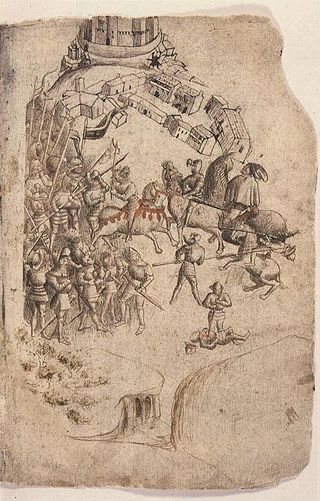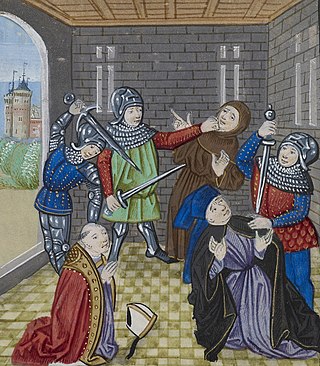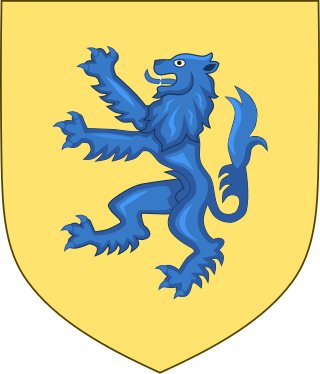Related Research Articles

The Battle of Bannockburn was fought on 23–24 June 1314, between the army of Robert the Bruce, King of Scots, and the army of King Edward II of England, during the First War of Scottish Independence. It was a decisive victory for Robert Bruce and formed a major turning point in the war, which ended 14 years later with the de jure restoration of Scottish independence under the Treaty of Edinburgh–Northampton. For this reason, the Battle of Bannockburn is widely considered a landmark moment in Scottish history.

Edward Seymour, 1st Duke of Somerset, 1st Earl of Hertford, 1st Viscount Beauchamp, also known as Edward Semel, was an English nobleman and politician who served as Lord Protector of England from 1547 to 1549 during the minority of his nephew King Edward VI. He was the eldest surviving brother of Queen Jane Seymour, the third wife of King Henry VIII.

Thomas Holland, 2nd Baron Holand, and jure uxoris1st Earl of Kent, KG was an English nobleman and military commander during the Hundred Years' War. By the time of the Crécy campaign, he had apparently lost one of his eyes.

Roger de Mortimer, 4th Earl of March, 6th Earl of Ulster was an English nobleman. He was considered the heir presumptive to King Richard II, his mother's first cousin.

Sir Ralph Sadler or Sadleir PC, Knight banneret was an English statesman, who served Henry VIII as Privy Councillor, Secretary of State and ambassador to Scotland. Sadler went on to serve Edward VI. Having signed the device settling the crown on Jane Grey in 1553, he was obliged to retire to his estates during the reign of Mary I. Sadler was restored to royal favour during the reign of Elizabeth I, serving as a Privy Councillor and once again participating in Anglo-Scottish diplomacy. He was appointed Chancellor of the Duchy of Lancaster in May 1568.

Thomas of Brotherton, 1st Earl of Norfolk, was the fifth son of King Edward I of England (1239–1307), and the eldest child by his second wife, Margaret of France, the daughter of King Philip III of France. He was, therefore, a younger half-brother of King Edward II and a full brother of Edmund of Woodstock, 1st Earl of Kent. He occupied the office of Earl Marshal of England.

Sir Robert Hales was Grand Prior of the Knights Hospitaller of England, Lord High Treasurer, and Admiral of the West. He was killed in the Peasants' Revolt.
Edward Hall was an English lawyer and historian, best known for his The Union of the Two Noble and Illustre Families of Lancastre and Yorke—commonly known as Hall's Chronicle—first published in 1548. He was also several times a member of the Parliament of England.

English nationalism is a nationalism that asserts that the English are a nation and promotes the cultural unity of English people. In a general sense, it comprises political and social movements and sentiment inspired by a love for English culture, language and history, and a sense of pride in England and the English people. English nationalists often see themselves as predominantly English rather than British.
The Scalacronica (1066–1363) is a chronicle written in Anglo-Norman French by Sir Thomas Grey of Heaton near Norham in Northumberland. It was started whilst he was imprisoned by the Scots in Edinburgh Castle, after being captured in an ambush in October 1355, and completed in England after his release. The chronicle documents the history of Britain until 1363, and is one of the few early chronicles written by a layman.

Henry de Beaumont, jure uxoris 4th Earl of Buchan and suo jure 1st Baron Beaumont, was a key figure in the Anglo-Scots wars of the thirteenth and fourteenth centuries, known as the Wars of Scottish Independence.

The Battle of Old Byland was a significant encounter between Scots and English troops in Yorkshire in October 1322, forming part of the Wars of Scottish Independence. It was a victory for the Scots, the most significant since Bannockburn.

Sir Thomas Grey or Gray of Heaton Castle in the parish of Cornhill-on-Tweed, Northumberland, was the son of Sir Thomas Grey, an eminent soldier in the Anglo-Scottish wars in the reigns of Edward I and Edward II, and his wife, Agnes de Bayles. He was the author of the English chronicle, the Scalacronica.
In July 1482 an English army invaded Scotland during the Anglo-Scottish Wars. The town of Berwick-upon-Tweed and its castle were captured and the English army briefly occupied Edinburgh. These events followed the signing of the Treaty of Fotheringhay, 11 June 1482, in which Alexander Stewart, Duke of Albany, the brother of James III of Scotland declared himself King of Scotland and swore loyalty to Edward IV of England. The follow-up invasion of Scotland under the command of Edward's brother, Richard, Duke of Gloucester failed to install Albany on the throne, but Berwick has remained English ever since the castle surrendered on 24 August. The English army left Edinburgh with a promise for the repayment of the dowry paid for the marriage of Princess Cecily of England to the Scottish Prince.

Thomas Montagu, 4th Earl of Salisbury, KG of Bisham in Berkshire, was an English nobleman and one of the most important English commanders during the Hundred Years' War.

Edward Balliol or Edward de Balliol was a claimant to the Scottish throne during the Second War of Scottish Independence. With English help, he ruled parts of the kingdom from 1332 to 1356.

Henry Percy, 9th Baron Percy of Topcliffe, 2nd Baron Percy of Alnwick was the son of Henry de Percy, 1st Baron Percy of Alnwick, and Eleanor Fitzalan, daughter of Sir Richard FitzAlan, 8th Earl of Arundel, and sister of Edmund FitzAlan, 9th Earl of Arundel.
Sir Andrew Murray (1298–1338), also known as Sir Andrew Moray, or Sir Andrew de Moray, was a Scottish military and political leader who supported King David II of Scotland against Edward Balliol and King Edward III of England during the Second War of Scottish Independence. He held the lordships of Avoch and Petty in north Scotland, and Bothwell in west-central Scotland. In 1326 he married Christina Bruce, a sister of King Robert I of Scotland. Murray was twice chosen as Guardian of Scotland, first in 1332, and again from 1335 on his return to Scotland after his release from captivity in England. He held the guardianship until his death in 1338.

Sir John Menteith of Ruskie and Knapdale was a Scottish nobleman during the Wars of Scottish Independence. He is known for his capture of Sir William Wallace in 1305 and later joined with King Robert I of Scotland and received large land grants in Knapdale and Kintyre for his service. He is described as "guardian" of the Earldom of Menteith, as his great-nephew Alan II, Earl of Menteith was a minor at the time of the death of Alan I, Earl of Menteith.
The Battle of Loch Ryan was fought on 9/10 February 1307 during the Scottish Wars of Independence near Stranraer on Loch Ryan, Galloway, Scotland.
References
- Weir, Alison (2005). Isabella, She-Wolf of France, Queen of England. Pimlico. ISBN 0-7126-4194-7.